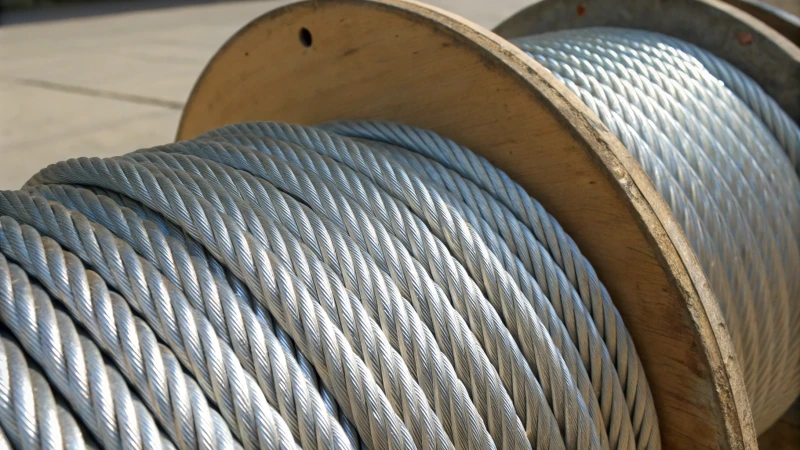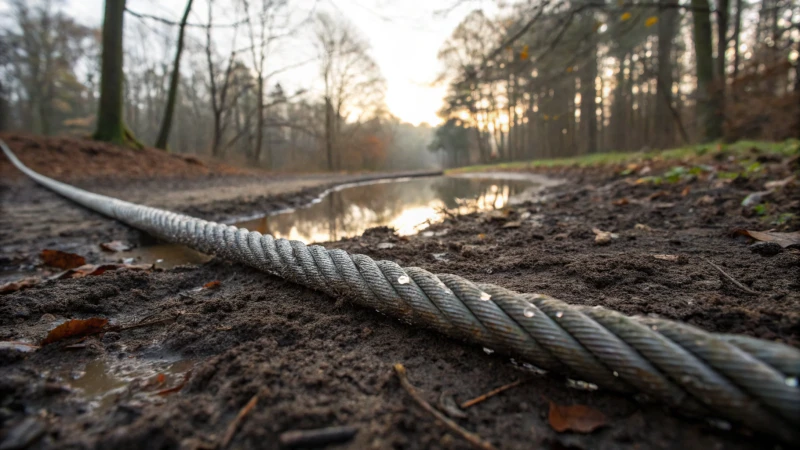
Ever felt stuck choosing between stainless steel and galvanized wire ropes for your project?
Stainless steel wire ropes triumph in corrosion resistance over galvanized ones, especially in salty environments. They last up to five times longer, perfect for marine settings, though they're pricier.
But here's the twist—it's not always a clear-cut choice. While stainless steel promises longevity, galvanized steel has its perks too. Let me walk you through the nitty-gritty of these options, including cost implications and specific uses, so you can confidently decide what suits your needs best.
Stainless steel ropes are more corrosion resistant than galvanized.True
Stainless steel offers superior resistance, especially in salty environments.
Galvanized ropes are five times more durable than stainless steel.False
Stainless steel is five times more durable, especially in marine settings.
What Are the Key Differences Between Stainless Steel and Galvanized Wire Ropes?
I remember the first time I faced the dilemma of choosing between stainless steel and galvanized wire ropes. It felt like a pivotal moment in my career, understanding how each type would impact the projects ahead.
Stainless steel wire ropes are ideal for marine environments due to their high corrosion resistance and durability but come at a higher cost. Galvanized wire ropes, while more affordable, provide sufficient rust protection in less demanding conditions.

Corrosion Resistance and Durability
I recall working on a project near the coast where every piece of equipment had to withstand relentless exposure to saltwater. In those moments, stainless steel wire ropes were my go-to choice. They're champions in fighting corrosion, offering a lifespan that could be five times longer than their galvanized counterparts. It's like having a loyal friend who never lets you down, even in the harshest conditions.
But then there are times when the budget whispers insistently in my ear. Enter galvanized wire ropes with their zinc coating. They offer a decent level of rust protection, perfect for situations where things are a bit less harsh but still need to stand up to moisture. Understanding corrosion resistance1 is crucial for making these calls.
Cost Considerations
There’s always that moment of hesitation when considering stainless steel for its price. It’s like buying a luxury car knowing it’s going to serve you well for years with minimal maintenance. Yes, the initial investment is higher, but over time, reduced replacements and maintenance often balance out the scales.
On the flip side, when the project doesn’t call for extreme resilience, galvanized ropes become the sensible choice. They fit snugly into tighter budgets without compromising on fundamental performance. Comparing material costs2 is a practical step for any cost-conscious buyer.
| Property | Stainless Steel Ropes | Galvanized Ropes |
|---|---|---|
| Corrosion Resistance | High | Moderate |
| Cost | Higher | Lower |
| Maintenance | Low | Moderate |
Application Suitability
For those grand projects by the sea or anywhere with constant saltwater presence, stainless steel ropes are indispensable. I've used them in shipbuilding and offshore drilling setups, where they hold their ground against corrosion and time.
In contrast, for construction or industrial tasks where exposure to severe weather isn’t as significant, galvanized ropes are more practical. They’ve proven their worth in cranes and lifting machinery over and over again—durable yet economical. Exploring industrial applications3 can reveal the best fit for each project.
Reflecting on these differences always guides me in making informed choices tailored to each project's unique demands.
Stainless steel ropes last five times longer than galvanized ropes.True
Stainless steel's superior corrosion resistance gives it a longer lifespan.
Galvanized wire ropes are more expensive than stainless steel ropes.False
Stainless steel is more costly due to its enhanced properties and durability.
How Do Environmental Factors Influence Wire Rope Choice?
Ever wondered how Mother Nature can sway your choice of wire rope?
Environmental factors like moisture, temperature, and chemical exposure shape wire rope selection by influencing durability and corrosion resistance. Picking the right material ensures top-notch performance and longevity across different conditions.

Corrosion Resistance
I remember the first time I had to choose a wire rope for a project near the ocean. It was all about beating that relentless sea air! In places where humidity or saltiness is high, like marine settings, corrosion resistance is a biggie. Stainless steel ropes shine here with their excellent corrosion resistance compared to galvanized ones. Though they come with a steeper price tag initially, their durability4 makes them worth every penny in the long haul.
| Material | Corrosion Resistance | Cost |
|---|---|---|
| Stainless Steel | Excellent | High |
| Galvanized Steel | Moderate | Medium |
Temperature Extremes
I've faced some scorching heat while working in the desert, and let me tell you, picking the right wire rope for extreme temperatures is no joke. In sizzling conditions, you need ropes with heat-resistant properties. On the flip side, if you're battling icy winds in cold climates, flexibility and brittleness resistance are crucial. Your material choice should reflect the temperature conditions5 you'll encounter.
Chemical Exposure
Industrial settings can be like a chemistry lab with all those chemicals flying around! It’s essential to pick a rope that has chemical-resistant coatings or materials to prevent degradation. Stainless steel often gets the thumbs up due to its resilience against various chemical agents6.
Load Capacity and Environmental Impact
The environment doesn't just mess with your hair; it also dictates load capacity needs. For example, in construction or heavy machinery use, where extra stress is a given, you need ropes with serious tensile strength. And with industries leaning towards greener solutions, sustainable materials are a win-win. Stainless steel ropes are catching on because they last longer and have a smaller environmental footprint.
In summary, when you're on the hunt for wire ropes, keeping an eye on environmental factors like moisture levels, temperature extremes, and chemical exposure is crucial for ensuring they perform well and last long in their specific roles. This savvy selection process not only boosts safety but also helps save money and go green.
Stainless steel ropes have better corrosion resistance than galvanized.True
Stainless steel offers superior corrosion resistance, especially in marine environments.
Galvanized steel ropes are more cost-effective than stainless steel.True
Galvanized steel is generally less expensive than stainless steel despite lower corrosion resistance.
Is Stainless Steel Always the Best Option for Corrosion Resistance?
Ever wondered if stainless steel is truly the best choice for corrosion resistance? Let's dive into this intriguing material's strengths and limitations.
Stainless steel's corrosion resistance comes from its chromium content, forming a protective oxide layer. Yet, in high-chloride settings like marine environments, materials like titanium or specific plastics might outperform stainless steel.

Understanding Corrosion Resistance
When I first learned about stainless steel, I was fascinated by its ability to withstand rust and corrosion, a feature due to its chromium content. This creates a passive layer of chromium oxide that acts like an invisible superhero cape, protecting the metal beneath. However, like any superhero, stainless steel has its kryptonite—certain environments can weaken its defenses.
Factors Affecting Stainless Steel's Performance
Imagine you're at the seaside, feeling the salty breeze. Now picture that same salt attacking your stainless steel in a marine setting. In high-salinity or chloride-rich environments, stainless steel might not fare so well and can suffer from pitting or crevice corrosion. I once read about titanium alloys7 being preferred in these conditions because of their robust protective oxide layer that laughs in the face of saltwater.
| Material | Resistance to Chlorides | Applications |
|---|---|---|
| Stainless Steel | Moderate | Construction, Kitchenware |
| Titanium | High | Marine, Aerospace |
| Plastics (e.g., PVC) | Variable | Chemical Handling |
Alternatives to Stainless Steel
It's like choosing the right gear for your adventure: while stainless steel is versatile, some plastics like PVC or HDPE might be your trusty companion in harsh chemical environments. They don't rust and can handle aggressive chemicals like pros. In industrial applications8, understanding what your adventure entails—be it chemical interactions or physical demands—is crucial.
Maintenance Considerations
Here's a reality check: stainless steel needs love and care to keep shining. Regular maintenance, cleaning, and sometimes protective coatings are part of its beauty regime. On the other hand, certain coated steels or composites might demand less upkeep, saving you some precious time and money on cost-sensitive projects. It's worth exploring alternative coatings9 for extended durability.
Economic and Environmental Impacts
Yes, stainless steel may ask for a higher upfront investment, but think of it as a long-term relationship—it’s durable and recyclable, making it a sustainable choice. Weighing costs10 and environmental impacts can help you decide if it’s worth the commitment.
Ultimately, by considering your unique needs, environmental conditions, and maintenance capabilities, you'll be better equipped to decide whether stainless steel is your perfect match or if another material might be your true corrosion-resistant champion.
Stainless steel is always the best for corrosion resistance.False
In high chloride environments, materials like titanium perform better.
Titanium alloys resist corrosion better than stainless steel in marine settings.True
Titanium's oxide layer offers superior protection in high salinity areas.
What are the long-term cost implications of each wire rope type?
Picture yourself standing on a bustling construction site, surrounded by towering cranes and heavy machinery. The wire ropes you choose today can make or break tomorrow’s success.
The long-term cost implications of wire ropes hinge on material type, durability, maintenance needs, and lifespan. Stainless steel ropes, while pricier upfront, offer remarkable durability and corrosion resistance. In contrast, galvanized ropes may cost less initially but often need frequent replacements.

Understanding Material Costs
I remember the first time I had to choose between stainless steel and galvanized wire ropes. The decision seemed overwhelming, like being at a crossroads without a map. Stainless steel ropes caught my attention with their promise of lasting power, especially in salty sea air—perfect for my marine projects. Yet, their price tag was enough to make anyone pause. Galvanized ropes seemed like the budget-friendly choice, but whispers of hidden maintenance costs lingered at the back of my mind.
Durability and Maintenance
Durability isn’t just a fancy word—it’s the backbone of any project. I've seen firsthand how stainless steel ropes laugh in the face of rust and wear, saving me from the hassle of constant replacements. These ropes are like that reliable friend who’s always there, come rain or shine. But then there are galvanized ropes; they need a bit more TLC to keep them going strong. I've learned that sometimes saving on initial costs can lead to more headaches down the road.
Lifespan and Replacement Frequency
In this industry, the saying "time is money" isn’t just a cliché—it's reality. The lifespan of wire ropes directly affects how often I have to replace them, and that means downtime I can't afford. With stainless steel ropes, I feel like I'm investing in peace of mind. They last longer and need fewer replacements, which keeps my projects moving smoothly.
Cost Comparison Table
| Wire Rope Type | Initial Cost | Maintenance Cost | Longevity |
|---|---|---|---|
| Stainless Steel | High | Low | Long |
| Galvanized | Low | Medium | Medium |
Environmental Considerations
As someone who strives to keep an eye on sustainability, I’m always looking for greener solutions. Stainless steel ropes fit that bill nicely due to their durability and reduced need for frequent replacement savings11. Their durability means fewer replacements, aligning with my goal to reduce waste. While galvanized ropes might be easier on the wallet upfront expenses12, they often fall short when it comes to meeting strict environmental standards.
Every time I weigh these factors, it feels like I'm playing a game of chess—each move carefully considered to ensure future success without sacrificing today’s budget. Understanding these nuances has been key to making informed decisions that not only serve immediate needs but also pave the way for sustainable growth.
Stainless steel ropes have lower maintenance costs than galvanized.True
Stainless steel's corrosion resistance reduces the need for frequent maintenance.
Galvanized ropes last longer than stainless steel ropes.False
Stainless steel ropes are known for their longevity compared to galvanized ones.
Conclusion
Stainless steel wire ropes offer superior corrosion resistance and durability, especially in marine environments, while galvanized ropes are more affordable but require more maintenance and have a shorter lifespan.
-
Explore how different materials withstand corrosive environments to choose the best option. ↩
-
Understand the cost implications of choosing between stainless steel and galvanized wire ropes. ↩
-
Discover which wire rope material is best suited for specific industrial applications. ↩
-
Explore why stainless steel wire ropes are favored for their durability in harsh environments, offering long-term cost savings despite higher upfront costs. ↩
-
Discover how different temperature conditions affect wire rope performance and the importance of selecting the right material for specific climates. ↩
-
Learn about the advantages of stainless steel wire ropes in environments with chemical exposure, ensuring longevity and reliability. ↩
-
Learn why titanium may be a better choice than stainless steel in highly corrosive environments. ↩
-
Discover applications where plastics outperform stainless steel in industrial settings. ↩
-
Find out about coatings that can extend the life of metals like stainless steel. ↩
-
Explore the cost implications of choosing stainless steel versus other materials. ↩
-
Uncover how stainless steel ropes contribute to sustainability by requiring fewer replacements. ↩
-
Explore how stainless steel ropes excel in marine settings due to corrosion resistance, reducing long-term costs. ↩

